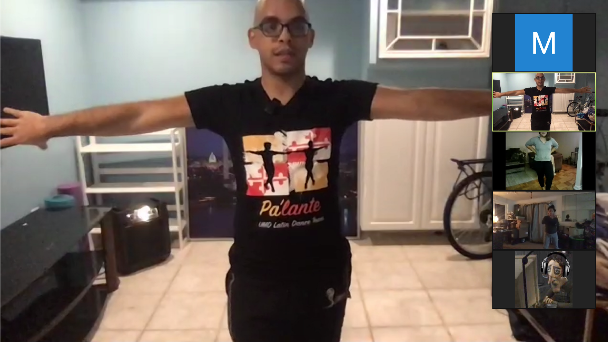By Madeline Herron
For The Diamondback
In celebration of National Hispanic Heritage Month, which started in mid-September and lasts until Oct. 15, I attended a virtual salsa dancing class. And it was absolutely incredible.
The class was hosted Wednesday evening by the Maryland Latin Dance Club and the Latinx Student Union. The organizations hired professional salsa and bachata dancer Juan Aristy to instruct the class. Despite Aristy’s impressive skills, this particular class was geared toward beginners like me.
The Zoom started off like any other typical academic lecture, with everyone muted and reluctant to turn their camera on. Prior to any dancing, Alyssa Gutierrez, president of the Latinx Student Union, started with a Kahoot trivia game about the history and culture of salsa dancing.
During the game, she explained a ton of interesting facts about the origins of salsa — my favorite was that salsa has some roots in Afro-Cuban dance.
“Everyone, say thank you Cuba!” Gutierrez joked.
Going into the dance lesson, I was very excited, and considering how much I love to dance, I expected to ace it pretty early.
As it turns out, I’m not quite the salsa expert I expected to be.
[Stamp Gallery’s ‘Connected Diaspora’ exhibit showcases connective power of social media]
Aristy first showed us what he referred to as a “basic” salsa combination. It was while learning eight beats worth of steps that I realized salsa dancing is a lot more complex than I thought.
I started to doubt if I would really be able to get the hang of salsa dancing, but Aristy’s encouraging step-by-step instruction slowly convinced me otherwise.
The “basic” sequence acted as the salsa routine’s home base. Every time Aristy taught us a few new steps, he would return to the original eight-step combination and include the newly taught moves at the end.
His method of teaching allowed me to focus on each new addition individually without forgetting the rest of the dance.
As the class progressed, my confidence in my dance moves grew to the point of being able to turn my camera on. By the time the class was over, I could do the entire routine by memory.
Although a single run-through of the moves we learned only lasted about 30 seconds, Aristy encouraged us to keep repeating the sequence and let our bodies move to the music.
[Three standout shows from a pandemic fashion week]
The Maryland Latin Dance Club typically holds these types of dance classes in person. However, due to the coronavirus pandemic, the club’s classes this semester will take place Mondays and Wednesdays on Zoom. The classes are open to everyone, so thankfully, I get to go back next week!
With COVID precautions resulting in the restriction of a lot of in-person activities, I’ve found it’s easy to lose motivation and get stuck in my room for a while. This class not only made me feel active again, but it connected me to a whole new community of really great people.
Liz Castillo, president of the Maryland Latin Dance Club, was excited to see how the event would turn out, and she described the class as a way of making the best out of transitioning to a virtual environment.
“We really want to educate people on what role salsa plays in Latin culture, and just kind of foster an appreciation for it as an art form,” Castillo said. “We want to make sure people have fun and bring a little enjoyment to their lives because everybody’s trapped in their houses right now.”
Overall, my experience with this class was fantastic. Not only did I learn about Latinx culture, but I also got to perform an entire salsa routine in my pajamas, all from the comfort of my living room.



